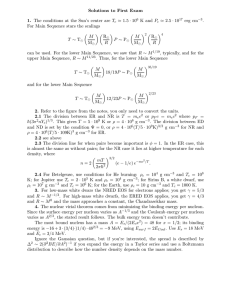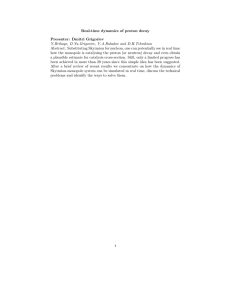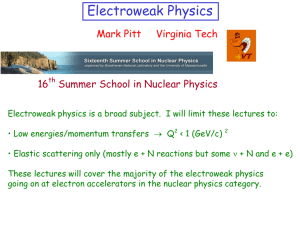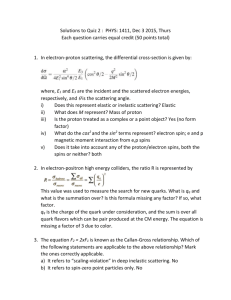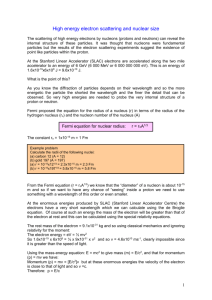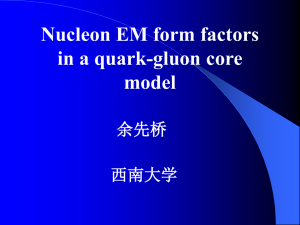Chapter 10
advertisement
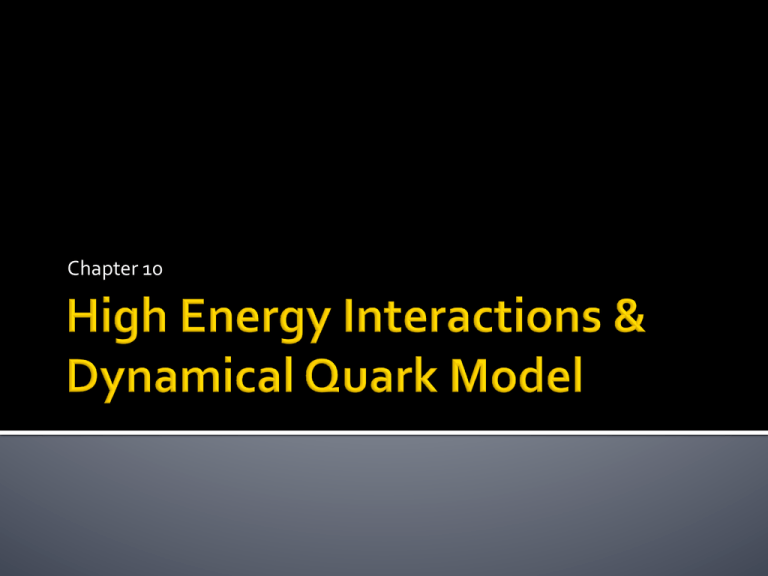
Chapter10
¡ ¡
Deepinelasticscatteringbetweenleptonsandnucleons
§ Confirmquarksaremorethanmathematicalobjects
§ Highmomentumtransferfromleptonstohadronconstituents
§ QCDpredictssmallcouplingbetweenquarksandgluonsatlarge
momenta
§ HighpTprocessescomputablewithperturbationmethods
¡
Reviewofhadron-hadroninteractions
§ Largecross-sections
§ LowpTprocessesformostcollisions
§ Involvementofhadronsaswhole,notonlyconstituents
§ NouseofperturbationtheoryforlowpTprocesses
§ Variousphenomenologicalmodels
28/04/16
F. Ould-Saada
3
¡
DIS
§ Informationaboutstructureofnucleon
§ l+Nàl’+X
§ Nucleonmadeofpartons
▪ Valencequarks
▪ Seaofquarksandantiquarks
▪ gluons
¡
DIS
§ Highmomentum
transferQ2vsshort
distances
§ 40000GeV2
(HERA)à10-18m
¡
Stage1
§ almostelasticl-qcollision
§ qcarriesfractionxofprotonmomentumP
§ virtualbosonabsorbedbyquark
§ structurefunctionF(x)describesmomentumdistributionofconstituentswithin
proton
▪
▪
¡
νNscatteringdependson3SFsrelatedto3helicitystatesofWbosons
eNdependson2SFsrelatedto2helicitystatesofγ
Stage2
§ Partonfragmentationintotwojetsofhadrons:
▪ Hadronisation“dresses”nakedquarkstoformfinalstatehadrons
▪ 1stjetstemsfrompartoninteractingwithlepton–high-ptatlargeangle
▪ 2ndspectatorjet(ortargetjet)comesfromspectatorpartons–low-ptindirectionofincidentparton
§ FragmentationfunctionD(z,Q2))–probabilitythatagivenhadroncarriesafractionzof
interactingpartonenergy
⎛M ⎞
⎛E⎞
⎛ E '⎞
⎝p⎠
⎝ p' ⎠
Proton P0 = ⎜ ! ⎟ ; electron P = ⎜ ! ⎟ ; P ' = ⎜ ! ⎟
Laboratory system
⎝0 ⎠
⎛ E '0 ⎞
⎛ν = E − E '⎞
Photon q = ⎜ ! ! ! ⎟ ; Hadronic system W = ⎜ ! ⎟
⎝ q = p − p' ⎠
⎝ p'0 ⎠
4 − momentum transfer
! ! 2
2
2
t = q 2 = ( P − P ') = ( E − E ') − ( p − p')
= 2me2 − 2EE´+2 pp´cosθ ≈ −4EE 'sin 2 (θ / 2) = −Q 2
high energy and small angles
2
p´≈ p , sin θ ≈ θ ⇒ t = q ≈ − p
2
θ2
4-momentum transfer to proton
! !
2
2
t = q = ( M − E '0 ) − 0 − p'0
(
Work out details
)
2
= 2M 2 − 2ME '0 = −2MTp
centre of mass energy
Scattering
§ Elastic:q2<0à
2
s = ( P + P0 ) = P 2 + P 20 + 2PP0 = me2 + M 2 + 2EM ≈ M 2 + 2EM
condition for elastic scattering
P0 ⋅ q = M ν = M (E − E ')
07/05/16
¡
F. Ould-Saada
space-like
§ Annihilationprocess:
q2>0àtime-like
6
¡
Elasticscatteringofspin-0point-likeelectron
(me,-e)byafixedpoint-likenucleus(M,Ze)à
Rutherford
¡
ElectronspinthroughDiracequation–no
protonspinàMott
§
§
¡
¡
¡
Backscattering(θ=π)forbidden
EMconserveshelicityàanisotropyàangular
dependency
Recoiloftarget–protonwithfinitemassà
E’/Eterm
§
MàinfinityèNSàM
Protonwithspin
" dσ %
$
' =
# dΩ &R
, " dσ %
" dσ %
" dσ % )
2
2 "θ %
2 "θ %
$
' =$
' +1− β sin $ '. ≈ $
' cos $ '
# dΩ &M # dΩ &R *
# 2 &- # dΩ &R
#2&
" dσ %
" dσ %
1
=
$
'
$
'
"θ %
# dΩ &NS # dΩ &M
1+ (2E0 / M )sin 2 $ '
#2&
+
" dσ % " dσ % (
q2
2 "θ %
tan $ '$
'=$
' *1+
# dΩ & # dΩ &NS ) 2M 2
# 2 &,
AtHEàmagneticmoment
2
,
/
"
%
"
%
d
σ
d
σ
q
2*
2 "θ %
2
oftargetinadditiontoelectric
(
2(1+ κ ) + tan $ ' + κ 0
$
'=$
' -1+
charge
# dΩ & # dΩ &NS . 4M 2 )
#2&
1
µ N = (1+ κ )µ 0
¡
Z 2α 2
"θ %
4E 20 sin 4 $ '
#2&
Spatialextensionofnucleus
§
àformfactorF
§ àExperimentalcrosssection
28/04/16
F. Ould-Saada
µ 0 = e! / 2M (Dirac point-like)
" dσ %
" dσ % ! 2 2
=
$
'
$
' F(q)
# dΩ &expt # dΩ &
7
¡
Spatialformfactor
§ toremovepointlike
approximation
§ describeelectriccharge
spatialdistribution
¡
F(q)isFouriertransformoff(r)
–f(r)inmomentumspace
ρ (r) = e f (r) =
dq
; ∫ f (r)dV = 1 ⇔
dV
!
1
F(q) ≡
Ze
∫e
!!
iq⋅ x
f (r)d 3 x
∫ ρ (r)dV = e
¡
FormFactors,ElectricchargedistributionandMagnetisation
/
" dσ % " dσ % ,
q2 (
2
2
2 2*
2 "θ %
2 2
2
$
'=$
' - F1 (q ) +
)2(F1 (q ) + κ F2 (q )) + tan $# '& + κ F2 (q )0
# dΩ & # dΩ &NS .
4M 2
2
1
¡
¡
p
p
n
n
Lowq2à F1 (0) = F2 (0) = F2 (0) = 1 ; F1 (0) = 0
Moreconvenient,Linear
combinationsàElectricand
MagneticFormFactors
(normalised)
q2
p,n
2
G (q ) = F1 (q ) −
κ
F
(q
)
2
4M 2
GMp,n (q 2 ) = F1p,n (q 2 ) + κ F2p,n (q 2 )
p,n
E
§ distributionsofelectriccharge
Rosenbluthformulafor
epscattering
§ Nointerference
betweenelectricand
magneticformfactors
28/04/16
p,n
2
GEp (0) = 1; GMp(0) = +2.79; GEn (0) = 0; GMn(0) = −1.91
andmagneticdipolemoment
¡
2
( 2
,
q2
2
G
+
G
2
*
" dσ %
" dσ % * E 4M 2 M
q
2
2 "θ %
+
GM tan $ '$
' =$
' )
2
q2
# dΩ &Ros # dΩ &NS *
# 2 &*
2M
1+
+
.
4M 2
F. Ould-Saada
Read more in book + study slides
9
¡
Summary
§ epscattering
§ FromRutherford
toRosenbluth
¡
Parameterisation:lineardependencyforconstantq2
" dσ %
" dσ %
2
2
2 "θ %
$
' /$
' = A(q ) + B(q )tan $ '
# dΩ &Ros # dΩ &NS
#2&
¡
¡
Parameterisation-Scalinglaw
Parameterisation-Dipole
formula
28/04/16
F. Ould-Saada
¡
ExperimentalproofthatScattering
mediatedbysinglephotonexchange
§
§
Figurenextslide
MeasurementofprotonandneutronForm
Factors
!
GMp(q 2 ) GMn(q 2 )
2
p
2
=
#G(q ) = GE (q ) =
µ
µn
"
p
# n 2
$GE (q ) = 0
%
(
'
*
1
2
'
*
G(q ) =
2
2
' q !"(GeV / c) #$ *
' 1+
*
&
)
0.71
2
11
Electricandmagneticformfactorsoftheprotonandmagneticformfactorofthe
neutron.
¡
f (r)dipole = 3.06 e−4.25r
¡
¡
f(r)-FouriertransformofG
HE:elasticFFverysmall,inelastic
scatteringmuchmorelikely!
28/04/16
F. Ould-Saada
small momentum transfer →
$
1
G (q ) ≈ f (0)&1− 2 2
&% 6q r
p
E
2
'
) ; r 2 = 0.81 fm
)(
12
¡
¡
¡
W:invariantmassfinal-state
hadrons>M
Q2:squaredenergymomentumtransfer
Q2,
2
W 2 = ( P0 + q ) = M 2 + 2P0 ⋅ q + q 2 = M 2 + 2M ⋅ ν − Q 2 > M 2
2independentvariables
§
¡
⎛M ⎞
⎛ν = E − E '⎞
Proton P0 = ⎜ ! ⎟ ; Photon q = ⎜ ! ! ! ⎟
⎝ q = p − p' ⎠
⎝0 ⎠
ν OR x,ν
Compareelastic(ES)e-parton(m)and
inelastic(IS)scatteringe-Proton(M)
§ W1,W2:structurefunctions
Q2
2M ν ≡ W + Q − M ; x ≡
2M ν
IS :
2M ν > Q 2 ; x < 1
2
2
2
ES :
W 2 = M 2 ; 2M ν = Q 2 ; x = 1
DIS :
Q 2 >> M 2 ; ν = E − E ' >> M
! d 2σ $
'
*
4πα 2 E '
2 !θ $
2
2
2 !θ $
cos # &)W2 (Q , ν ) + 2W1 (Q , ν )tan # &,
# 2 & =
4
" 2 %(
" 2 %+
Q E
" dQ dν %IS
⎛ d 2σ ⎞
⎡
⎤ ⎛
4πα 2 E '
Q2
Q2 ⎞
2 ⎛θ ⎞
2 ⎛θ ⎞
cos ⎜ ⎟⎢1+ 2
tan ⎜ ⎟⎥δ ⎜ν −
⎜ 2 ⎟ =
⎟
4
2
⎝ 2 ⎠⎣
⎝ 2 ⎠⎦ ⎝
Q E
4m
2m ⎠
⎝ dQ dν ⎠ES
28/04/16
F. Ould-Saada
13
Comparinge-Pande-pàConditiononstructurefunctions(SFs):
¡
1 ⎛
Q2 ⎞
Q2 ⎛
Q2 ⎞
2
W2 (Q , ν ) → δ ⎜ν −
δ ⎜ν −
⎟ ; W1 (Q , ν ) →
⎟
ν ⎝
2m ⎠
4m 2ν ⎝
2m ⎠
2
Bjorken,1967
¡
§ InDIS,SFsdependondimensionlessvariables
§ haveonlyveryweakdependenceonQ2,onνandonnucleonsize,asinEScase
Bjorkenscalinglaw
¡
⎫
Q2
Q ,ν → ∞ ⇒ x ≡
finite ⎪
⎬⇒ x=m/M
2M ν
Q 2 = 2mν (elastic scattering)⎪
⎭
2
§
§
x:fractionofnucleonmasscarriedbypartoninteractingwithlepton
èstructurefunctiononlydependsonx,notonQ2andν
2
2
,ν →∞
,ν →∞
ν W2 (x,Q 2 ) ⎯Q⎯⎯
⎯
→ F2 (x) ; MW1 (Q 2 , ν ) ⎯Q⎯⎯
⎯
→ F1 (x)
07/05/16
F. Ould-Saada
14
¡
SLAC,1968
§ Linearaccelerator,3km
§ Ee=20GeVonHandDtargets
§ MeasureE’andθ
E ', θ ⇒ Q 2 , ν ,W
¡
Data
d 2σ
= f (W )
dΩdE '
§ ElasticpeakW=M(removed)
§ W~1.2-1.8GeV:excitationofbaryonicresonances(Δ(1230MeV)
§ W>1.8GeV:continuumwithnoresonances
¡
AtfixedW–
§ CrosssectiondecreasesrapidlywithincreasingQ2(Formfactor–figureslide12)
§ InelasticScattering~constantforQ2>1àBjorkenscaling
¡
e-Pinteraction
§ ratiobetweenelastic(solid
curve)andinelasticcrosssections(points)andMott
cross-section(onapoint-like
andspin-lesstarget)asa
functionQ2
§ ISincreasinglymore
importantthanES:Q2>1
¡
AtfixedW
§ IS~constantforQ2>1
§ Bjorkenscaling
¡
¡
Atfixedx,structurefunctions
F1,2haveveryweak
dependenceonQ2asshown
bydataforQ2from2to18
GeV2
§ àScalingbehaviour
AsFouriertransformofa
sphericallysymmetricpointlikedistributionisaconstant
§ àprotonhasasub-structure
ofpoint-likecharge
constituents
▪ Moreinchap14
28/04/16
F. Ould-Saada
17
28/04/16
F. Ould-Saada
–
(a) λγ >> dN:thephoton"sees"a
point-likenucleon
–
(b) λγ ~ dN:thecrosssection
dependsonq2throughaform
factor,F(q2/M2N),correspondingto
thechargedensityofthenucleon.
Tokeeptheformfactor
dimensionless,amassscaleis
necessary,takentobethemassof
thenucleon,MN.
–
(c) λγ << dN:thephotoninteracts
directlywithaparton,
independentlyontherestofthe
nucleon.Thecrosssection
becomessimpler.
18
¡
¡
e-scatteringonspin
½particlem=xM
e-Pwithstructure
.
+
" dσ % " dσ % (
Q2
2 "θ %
$
'=$
' *1+ 2τ tan $ '- ; τ =
0
# dΩ & # dΩ &NS )
# 2 &,
4m 2
0
2W1
⇒
= 2τ
/
2
(
+
W
" dσ %
dσ
2
2
2
2 "θ % 0
=$
' *W2 (Q ,ν ) + 2W1 (Q ,ν ) tan $ '-0
# 2 &,1
dΩdE' # dΩ &NS )
F2 %
ν F1 Q 2 )
; W2 → ' ⇒
=
+
ν&
M F2 4m 2 +
*
2
+
Q
Q 2 = 2mν ⇒ m =
= xM
+
,
2ν
⇒ 2xF1 = F2 Callan-Grossrelation
"
F1
W
→
1
$#
M
F1 (x,Q 2 )=0 ⇒spin = 0
2xF1 (x,Q 2 ) = F2 (x,Q 2 ) ⇒spin =
28/04/16
1
2
F. Ould-Saada
19
Q2
dx x
d x d
x=
→
= →
=
2M ν
dν ν
dx ν dν
(
+
d 2σ
x d 2σ
4πα 2 E ' 1
2 "θ %
2
2
2 "θ %
=
=
cos
ν
W
(Q
,
ν
)
+
2
ν
W
(Q
,
ν
)
tan
$ '* 2
$ '1
# 2 &)
# 2 &,
dQ 2 dx ν dQ 2 dν
Q4 E x
(
+
4πα 2 E ' 1
ν
2 "θ %
2 "θ %
=
cos
F
(x)
+
2
F
(x)
tan
$ '* 2
$ '1
# 2 &)
# 2 &,
Q4 E x
M
Work out details in book
'
*
d 2σ
4πα 2 E ' 1
Q2
2 !θ $
2 !θ $
=
cos # &) F2 (x) + 2xF1 (x)
tan # &,
" 2 %(
" 2 %+
dQ 2 dx
Q4 E x
4M 2 x 2
(
+
d 2σ
4πα 2 E ' F2 (x)
Q2
2 "θ %
2 "θ %
F2 (x) = 2xF1 (x) ⇒
=
cos $ '*1+
tan $ '# 2 &) 4M 2 x 2
# 2 &,
dQ 2 dx
Q4 E x
¡
Infinite(nucleon)momentumreference
frame:|p|>>M
¡
§ Neglectmassesandtransversemomenta
§ 4-momentumP0ofnucleondistributed
§ Nucleonconsistsofpoint-likeparticles,
partons
§ 4-momentumP0ofnucleondistributed
amongpartons
ISwith(Q2,ν)resultofESonpartonof4p=xP0
amongpartons
¡
StructureFunctionF2(x)/xisdistribution
functionofpartonsinnucleon
¡
Interpretationofscalingsimplestinareferenceframewheretargetismoving
withveryhighvelocity(InfiniteRF)
§ pTandrestmassesofconstituents
(partons)maybeneglected
¡
PartonModel(partons=quarks+gluons)
§ Targetnucleon=streamofpartonswith4-momentumxP
§ x=fractionofnucleon3-momentumcarriedbypartonininfiniteRF
§ Ifoneparton(mass:m)scatteredbyphoton(4-momentum:q)
!
!
P = ( p, p) ; p = p (M ≈ 0)
( xP + q)
2
= ( x 2 P 2 + 2xP ⋅ q + q 2 ) = m 2 c 2 ≈ 0
q2
Q2
If x P = x M c << Q ⇒ x = −
=
2P ⋅ q 2M ν
2
28/04/16
2
F. Ould-Saada
2
2 2
2
Invariant
P.q
evaluated
in lab
21
Parton4-momentumaftertheinteraction
¡
(q + xP0 )
2
2
2
2
2
2
= −Q
+
2xM
⋅
ν
+
x
M
=
m
<<
W
!##"##
$
0
¡
¡
x=fractionofnucleon3-momentumcarriedbypartonininfiniteRF
EquivalenttopartonofmassmstationaryinlabSystem,withelasticrelation
Q2
m
Q = 2mν ; if Q >> M c ⇒ x =
=
2 Mν M
2
¡
2
Q2
x=
2Mν
2 2
€
x=fractionofnucleonmasscarriedbystruckparton
¡
Toidentifyconstituentpartonswithquarks,needtoknowspinandelectriccharge
¡
¡
¡
qf(x):quarkdensities/momentumdistributionofquarkofflavourf
qf(x)dx:probabilityoffindinginanucleonaquarkofflavourfwithmomentum
fractioninintervalxtox+dx
Nucleon=valencequarks(carryobservedquantumnumbers)+seaquarks(q-qbar
pairsfromradiatedgluons)
[
]
F2 (x) = x ∑ e 2f q f (x) + q f (x)
f
#1
&
4
1
F2lp (x) = x % ( d p + d p ) + ( u p + u p ) + ( s p + s p ) (
$9
'
9
9
#1 n
&
4 n
1 n
ln
n
n
n
F2 (x) = x % ( d + d ) + ( u + u ) + ( s + s ) (
$9
'
9
9
Isospin symmetry :u ↔ d ⇒ n ↔ p
∫
F eN
2 (x)
= ∑ e 2f
x
f
F2lN (x) =
∑
xq f (x)e 2f
f =1,N q
⇒ u p (x) = d n (x) ≡ u(x) ; d p (x) = u n (x) ≡ d(x) ; s p (x) = sn (x) ≡ s(x)
€Isoscalar target : N p = N n
F2lN (x) =
28/04/16
1 lp
5
1
ln
F
(x)
+
F
(x)
=
x
q(x)
+
q
(x)
+
[
] x [ s(x) + s (x)]
∑
[
]
2
2
2
18 q =u,d
9
F. Ould-Saada
23
F2 (x)= x∑ e 2f "#q f (x) + q f (x)$%
f
F2lN (x) =
5
x ∑ [ q(x) + q(x)]
18 q=u,d
1
+ x [ s(x) + s (x)]
9
∫ F eN2 (x) ≅ 0.14 →
18
∫ x [q(x) + q(x)]dx ≅ 5 ⋅ 0.14 ≅ (0.50 ± 0.05)
1
0
F2ν p (x)= x ∑ [ q(x) + q(x)]
q=u,d
⇒ F2ν N (x) ≤
18 lN
F2 (x)
5
%18
(
Data ⇒ ' F2lN (x) ≅ F2ν N (x)*
&5
)
2
1
⇒ Parton Charges:+ and −
3
3
28/04/16
F. Ould-Saada
24
¡
Weakcrosssection(GF
insteadofαQED)
§ 3structurefunctions
F1,F2,F3,
§ F3takesintoaccount
ParityviolationinWI
Q2
x=
2M ν
ν
Q2
y= =
E 2MxE
E
y = µ (1− cosθ )
Mx
dQ 2 = 2MExdy
d 2σ
d 2σ
= 2MEx
dxdy
dxdQ 2
'
*
d 2σ
4πα 2 E ' 1
Q2
2 !θ $
2 !θ $
=
cos
F
(x)
+
2xF
(x)
tan
#
&
#
&
) 2
,
1
" 2 %(
" 2 %+
dQ 2 dx
Q4 E x
4M 2 x 2
⎤
⎛ y⎞
d 2σ ν ,ν GF2 MEν ⎡⎛
Mxy ⎞
2
=
⎢⎜1− y −
⎟ F2 (x) + xy F1 (x) ∓ xy ⎜1− ⎟ F3 (x)⎥
⎝ 2⎠
dxdy
π ⎣⎝
2Eν ⎠
⎦
Eν >> M ⇒
Mxy
≈0
2Eν
d 2σ ν ,ν σ 0 ⎡
=
Eν ⎣( F2 (x) ∓ xF3 (x)) (1− y)2 + ( F2 (x) ± xF3 (x))⎤⎦
dxdy
2
d 2σ
= A(x) + (1− y)2 + B(x)
dxdy
GF2FM
σ0 =
= 1.58⋅10 −38 cm 2GeV −1
π
Work out details in book
v e e − → ve e −
v e e − → ve e −
¡
2
Purelyleptonicprocesses dσ (ν e− ) = GF s e
2
§ J=0àisotropy
§ J=1àangular
dependency
§ Scatteringthrough
180oforbidden
§ amplitudewithfactor
(1+cosθ)
dΩ
4π
dσ
GF2 s $ 1+ cosθ '
−
(ν ee ) ∝ 2 &
)
dΩ
4π % 2 (
2
dy
1
=
dΩ 4π
dσ GF2 s
=
dy
π
dσ GF2 s
2
=
(1− y)
dy
π
2
HE : ECM
≈ 2mec 2 Eν
1
⇒ σ tot (ν ee− ) = σ tot (ν ee− )
3
¡
CompareνeandνN
§ J=0àisotropy
§ J=1àangular
dependency
§ Valenceandseaquarks
innucleon!
vµ d → µ −u
J =0
vµ d → µ +u
J =0
vµ u → µ − d
J =1
vµ u → µ + d
J =1
dσ ν e GF2 s
=
dy
π
d 2σ ν N 2GF2 MEν "
2$
=
xq(x)
+
xq(x)
1−
y
(
)
#
%
dx dy
π
dσ ν e GF2 s
2
=
(1− y)
dy
π
d 2σ ν N 2GF2 MEν "
2
$
=
xq(x)
1−
y
+
xq(x)
(
)
#
%
dx dy
π
(25)
d 2σ ν ,ν σ 0 "
=
Eν #( F2 (x) ∓ xF3 (x)) (1− y)2 + ( F2 (x) ± xF3 (x))$%
dxdy
2
"
1 ν
F 2 (x) − xF ν3 (x)) = 2xq(x)$
(
$
2
#
1 ν
F 2 (x) + xF ν3 (x)) = 2xq(x) $
(
$
%
2
ν
'
$ F 2 (x) = 2x ( q(x) + q(x))
⇒( ν
$ xF 3 (x) = 2x ( q(x) − q(x))
)
Work out details in book
¡
Possibleinteractions
§ u,d,ands
§ F2dependsonvalenceandsea
quarks
§ F3dependsonvalencequarks
only
F ν2 p (x) = 2x ( d(x) + u(x))
ν
⎧
⎪ F 2 (x) = 2x ( q(x) + q(x))
⎨ ν
⎪
⎩ xF 3 (x) = 2x ( q(x) − q(x))
xF ν3 p (x) = 2x ( d(x) − u(x))
F ν2 p (x) = 2x (u(x) + d (x))
p
xF ν3 (x)
= 2x (u(x) − d (x))
§ Isoscalartarget
F ν2 N (x) = F ν2 N (x) = x (u(x) + u(x) + d(x) + d (x) + s(x) + s (x))
xF ν3 N (x) = F ν3 N (x) = x (u(x) + d(x) + s(x) − u(x) − d (x) − s (x))
= x (uv (x) + dv (x))
§ MeasurementofF2&F3èextractdistributionfunctions
¡
Numberofvalencequarksinthenucleon:3
xF ν3 N (x)
nv = ∫
dx =
0
x
1
¡
1
∫ [u (x) + d (x)] dx ≅ 2.8 ± 0.5
0
v
v
50%ofnucleonmomentumcarriedbynonEWparticles–gluons
∫
1
0
F2ν N (x)dx ≅
¡
ns =
∫
1
18
5
∫
1
0
Nostrangenessinnucleon
x [ s(x) + s (x)] dx =
0
¡
1
F2lN (x)dx = 0.49 ± 0.06
# lN 5 ν N &
∫ 0 %$9F2 − 2 F2 (x)(' dx = 0.05 ± 0.18
1
Seaquarkscarrynoprotonmomentum
nsea = ∫ x !"u(x) + d (x)#$ dx =
0
∫
1
!" F2ν N + xF3ν N (x)#$ dx = 0.02 ± 0.03
0
¡
¡
¡
IntegralofPDFs
Extractionfromcombinationofcrosssections
Inproton,u&dquarkshavelargest
probabilitydensityatlargex
§ residualmemoryofx~1/3forvalence
quarks
§ reductionduetogluonemission
¡
Gluonsand“sea”anti-quarkshavelarge
probabilityatlowx.
§ gluonscarry~50%ofprotonmomentum
1
σ 0 Eν
1
σ 0 Eν
¡
∫
d 2σ ν N
2
dx dy = ∫ #$ xq(x) + xq(x) (1− y) %&dxdy = 0.3+ 0.06 / 3 = 0.32
dx dy
∫
d 2σ ν N
2
dx dy = ∫ #$ xq(x) (1− y) + xq(x)%&dxdy = 0.3 / 3+ 0.006 = 0.16
dx dy
Makeuseofexperimentalvaluesofpreviousslidetoestimateratioof
crosssections
σ ∝E
σ (ν N )
≈2
σ (ν N )
¡
Q2dependenceof
StructureFunctions
¡
¡
¡
Freequarks
Gluonexchange
Gluonemission
Scalingisapproximately
correctbutnotexact
¡
¡
Deviationsfromscalingdueto
QCDcorrectionstoQuark
PartonModel
§ Quarkcanradiategluon
§ Gluoncansplitintoqqbaror
gg
¡
AnalysisofdatawithQCD
correctionsàαsandΛ 28/04/16
F. Ould-Saada
33
¡
QCDnicelyexplainsdata
¡
Cross-sectionmeasurementsinppandppbar
collisions
§ dataincludehighenergycosmicrayinteractions
¡
Transversemomentum
§ Highpt:rapidincreasewiths,lowcrosssections,
perturbativemethods(QCD)
§ Lowpt:ln(s)increase,highcrosssections,nonperturbativemethods(αstoolarge)
▪
Phenomenologicalmodelsbasedonmany-bodyQCD
pomeron,apseudo-particlewiththe
quantumnumbersofthevacuum
¡
Schematicrepresentationofthe
statusoftwohadronsbeforecollision
for
§ (a)peripheraland
§ (b)centralcollisions.
Duetorelativisticeffects,thetwo
hadronscontractalongthedirectionof
motion.
§ (c)Sketchoftheincreasewithenergy
ofthehadronsizeandopacity–
protondarker
(relativisticcontractionnotshown)
§ Opacity:
¡
Exampleofmeasurements
enteringmodelbuilding
¡
¡
HEnucleus-nucleus(A-A)collisionsstudiedsinceendof1980susingion
beams8O,16S,82Pb
§ at15GeV/nucleonatBrookhaven
§ at200(158for82Pb)GeV/nucleonattheCERNSPS
ResultsshowthattheA-Acollisioncanbeexplainedasaseriesofhadron–
nucleuscollisions(superpositionmodel).
§ Onlyfewnucleonsoftheprojectile(ortarget)interactinelastically,producinga
heavynuclearfragment,somelightfragmentsandseveralspectatornucleons.
§ About20%ofthesenucleonsreinteractsinsidethetargetnucleus.
§ Thehadron–nucleusinteractionisthusconsideredasasuperpositionofhadronhadroninteractions.
¡
OneofthemostusedmodelsinMonteCarlosimulationsofA-A
interactions:Glaubermodelofmultiplenuclearscattering:
§ ahadroncrossinganucleuscanundergomultipleinteractions
§ ineachinteraction,hadronsareproducedwhichmayinturninteractwithinthe
samenucleus,givingrisetoaintra-nuclearcascade.
¡
A-AinteractionsareimportantinthestudyofcascadesinducedbyHE
cosmicrays(p,Heandheaviernuclei)withnucleiintheupperatmosphere
¡
¡
HEA-Acollisionsusedtosearchforpossiblestateofmatterdenoted-QGP
Theveryhightemperaturesanddensitiesachievedinthecollisionsshould,
foraveryshorttime,allowquarksandgluonstoexistinafreestate,i.e.,no
longerconfinedinhadrons,inakindof“soup”orplasma.
¡
Stateofmattermighthaveexistedaround10-6safterBigBang.
§ PredictedbyQCD
¡
TheBrookhavenRelativisticHeavyIonCollider(RHIC),2000,devotedto
thesestudies
§ goldionswhichcollidingat56–130GeV/nucleon.
§ RHICmayhaveindicationsforaQGPbehavingmorelikealiquidthanagas.
¡
¡
AtLHC,ALICE(aswellasATLASandCMS)studiesindetail82Pbion
interactionsupto5.5TeV/nucleon.
ThestudyofthepropertiesofQGP
§ canhelptounderstandtheoriginofparticles(p,n)
§ mayalsohaveimportantimplicationsforourunderstandingofcosmology.
¡
10.9
§ ReadtheSlidespresentedatCERNonheavyioncollisionsandALICE
¡
10.10TheLHCandtheSearchfortheHiggs
§ Readthissectioninthebook–wealreadydiscussedtheHiggsinthe
previouschapter
§ ReadtheSlidespresentedatCERNonATLAS,Higgsandother
searches
▪ InparticularitisimportanttoknowhowtheHiggsisproducedine+e-and
hadroncolliders,howitdecaysdependingofitsmassandhowitis
discovered!
¡
Solveproblems
§ 10.2,10.3
§ 10.6,10.7
